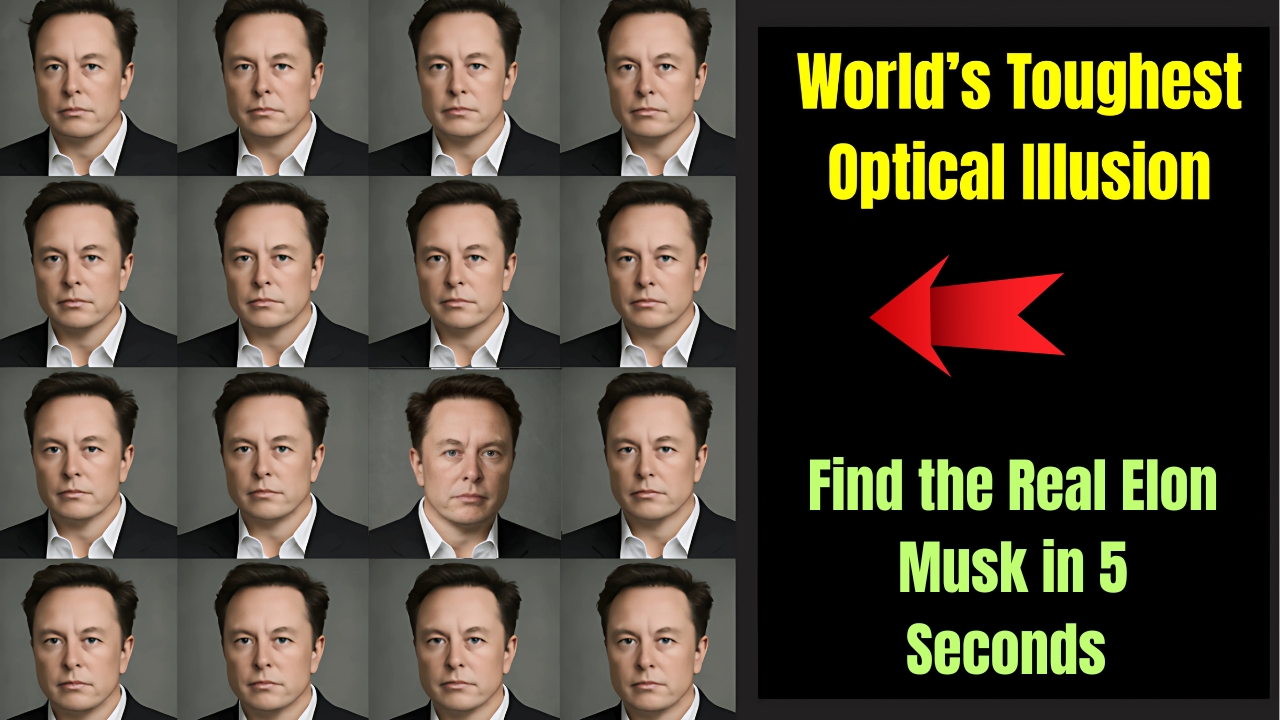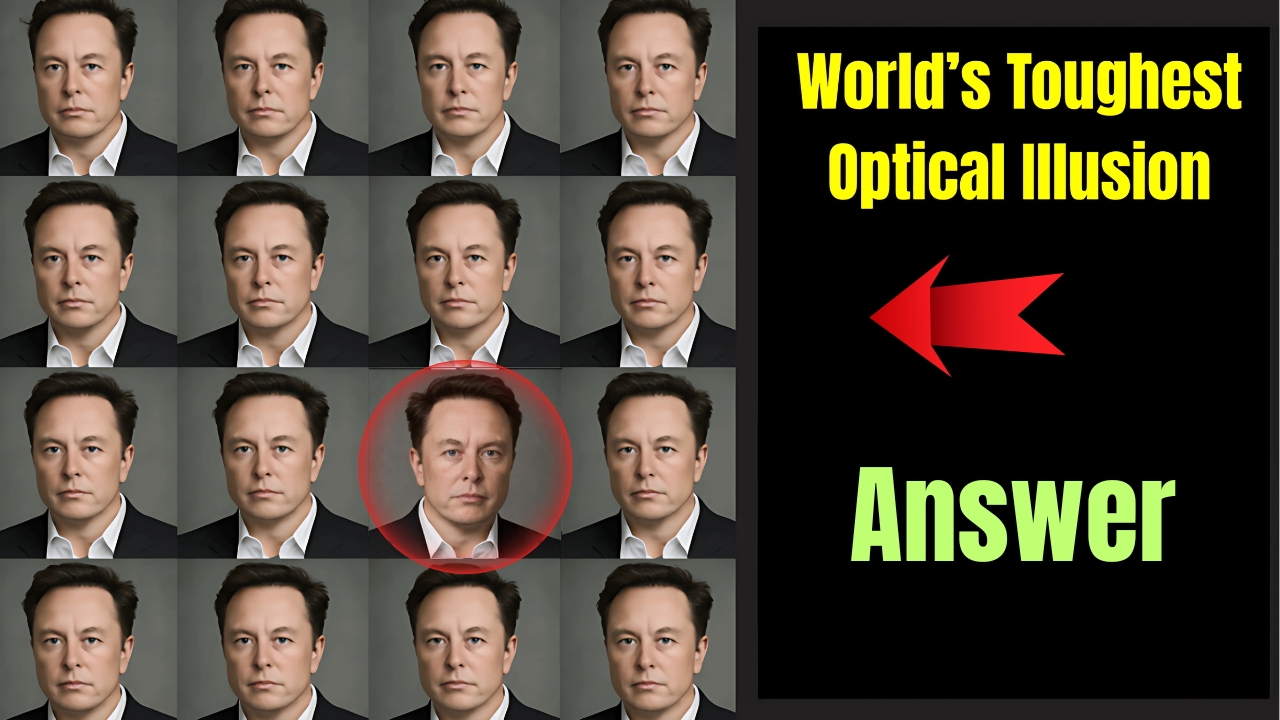The intersection of technology, perception, and viral culture has never been more fascinating than in 2025, where Elon Musk continues to dominate not just headlines but also the world of optical illusions. From brain-bending visual tricks that exploit our cognitive shortcuts to cutting-edge neural technologies that promise to restore sight itself, Musk-related optical phenomena are capturing global attention like never before.
The Latest Viral Sensation: Find the Odd Elon Musk Challenge
Breaking the Internet in July 2025

The most recent optical illusion to sweep social media is the “Find the Odd Elon Musk” challenge, which exploded across platforms on July 2, 2025. This deceptively simple puzzle presents viewers with a grid of identical cartoon faces resembling the Tesla CEO, but with one crucial difference hidden among the uniformity. The challenge? Spot the odd one out in just seven seconds.
What makes this particular illusion especially compelling is its timing, coinciding with major developments in Musk’s various ventures. As SpaceX prepares for late 2025 Mars rover tests and Tesla unveils its AI-enhanced autopilot system integrating xAI technology, this playful challenge serves as a cultural touchstone reflecting Musk’s omnipresent influence.
The Psychology Behind Quick Recognition
This latest challenge taps into fundamental aspects of human visual processing, specifically our pattern recognition abilities and selective attention mechanisms. When presented with a dense field of similar shapes, our brains can easily overlook subtle differences—a phenomenon that has profound implications for everything from cybersecurity to autonomous vehicle development.
The seven-second time limit isn’t arbitrary; it mimics real-world scenarios where rapid decision-making is crucial. This pressure creates a cognitive stress test that reveals how our visual attention operates under constraint, making it both entertaining and scientifically relevant.
The Science of Musk-Related Optical Illusions
The Thatcher Effect: When Faces Fool Us
The most scientifically significant Musk optical illusion remains the Thatcher Effect variation created by The Sun in 2022, which continues to circulate and baffle viewers in 2025. This unsettling image appears normal when viewed upside-down but reveals a disturbing, distorted face when rotated 180 degrees.
Understanding this illusion requires diving deep into how our brains process facial information. The fusiform gyrus, our brain’s specialized face-processing region, operates optimally for upright faces. When faces are inverted, this system struggles to detect spatial relationships between features, causing us to miss even dramatic distortions.
Modern Applications and Neural Technology
Remarkably, Musk’s real-world ventures are beginning to intersect with the science behind these illusions. Neuralink’s Blindsight technology, which received FDA breakthrough device designation in 2024 and is preparing for its first human trials by the end of 2025, directly addresses visual perception challenges.
The Blindsight implant works by placing microelectrode arrays into the visual cortex, essentially bypassing damaged eyes and optic nerves to create artificial vision. While Musk has claimed this technology could eventually provide “superhuman vision,” scientists remain more cautious about its initial capabilities, comparing early results to “Atari graphics.”
Cultural Impact and Social Media Phenomena
X Platform Integration and Viral Mechanics
The relationship between Musk’s optical illusions and his ownership of X (formerly Twitter) creates a unique feedback loop. When Musk himself engages with these challenges—as he did with previous rotating cube illusions and letter-grid puzzles—it amplifies their reach exponentially, drawing millions into the collective puzzle-solving experience.
This dynamic illustrates how modern social media can transform simple cognitive tests into global cultural events. Hashtags like #OddElonChallenge and #MuskPuzzle have become trending topics, with users sharing completion times and strategies, creating competitive communities around visual perception challenges.
The Logo Correction: Art Meets Science
Even Musk’s business ventures haven’t escaped optical illusion challenges. The X logo itself underwent subtle modifications to correct the Poggendorff illusion—a visual phenomenon where intersecting lines appear misaligned when partially obscured. This correction, identified by designer Will Paterson, demonstrates how optical illusions influence even corporate branding decisions.
The Broader Implications for 2025 and Beyond
Artificial Intelligence and Visual Processing
As xAI’s Grok 3 continues advancing AI capabilities, the intersection of artificial intelligence and optical illusions becomes increasingly relevant. These puzzles serve as informal benchmarks for both human and artificial visual processing systems, highlighting areas where human perception excels or fails compared to computational approaches.
The entertainment value of finding hidden elements in visual grids parallels serious challenges in computer vision, from medical imaging analysis to autonomous vehicle object recognition. The same cognitive shortcuts that make us susceptible to illusions can inform how we design AI systems that need to process visual information reliably.
Medical and Therapeutic Applications
Beyond entertainment, Musk-related optical illusions are finding applications in cognitive assessment and therapy. The seven-second challenge format provides a standardized method for testing visual attention and processing speed, potentially useful in diagnosing attention disorders or tracking cognitive changes over time.
As Neuralink prepares for human trials of Blindsight, understanding how normal visual perception works—including its vulnerabilities to illusions—becomes crucial for developing effective neural interfaces that can create meaningful artificial vision.
Solving the Puzzles: Strategies and Techniques
Methodical Approaches to Visual Challenges
Successfully navigating these optical illusions requires systematic approaches that can be applied broadly. For grid-based challenges like the “Find the Odd Elon Musk” puzzle, experts recommend starting from the top-left corner and moving methodically right then down, giving each element a brief but focused examination.
The key insight is that peripheral vision often catches anomalies that focused attention misses. By maintaining a slightly relaxed gaze while scanning, viewers can leverage their brain’s pattern detection systems more effectively.
Training Visual Attention
Regular engagement with these challenges can actually improve visual attention skills. Like physical exercise strengthens muscles, consistent practice with optical illusions can enhance the brain’s ability to process visual information quickly and accurately—skills that translate to real-world benefits in everything from driving safety to professional tasks requiring visual detail detection.
Looking Forward: The Future of Perception
Technology and Human Enhancement
As 2025 progresses, the line between natural and artificial vision continues to blur. Musk’s claims that Blindsight could eventually enable infrared, ultraviolet, or radar wavelength vision represent a fundamental shift in how we might experience visual reality.
These developments raise profound questions about the nature of perception itself. If technology can provide enhanced visual capabilities, will future optical illusions need to account for superhuman vision? How will our understanding of visual cognition evolve as artificial enhancement becomes possible?
Cultural Evolution of Visual Challenges
The viral success of Musk-related optical illusions reflects broader cultural trends toward gamified learning and social media-driven education. These challenges combine entertainment with cognitive exercise, creating engaging ways to explore complex scientific concepts about perception and consciousness.
As AI tools become more sophisticated, we can expect optical illusions to evolve alongside them, potentially incorporating interactive elements, personalized difficulty levels, and real-time neural feedback that could revolutionize how we understand and train visual perception.
Optical Illusions Answer

Frequently Asked Questions
Q: How quickly can most people solve the “Find the Odd Elon Musk” challenge? A: Most successful solvers identify the difference (a slight red tint in the hair) within 5-10 seconds, with some claiming sub-5-second completion times on social media.
Q: Why does the Thatcher Effect work so effectively with celebrity faces like Musk’s? A: Celebrity faces are highly familiar, making our brains more confident in their recognition, which paradoxically makes us more susceptible to missing distortions when the face is inverted.
Q: Will Neuralink’s Blindsight technology be able to prevent optical illusions? A: Initially unlikely, as early versions will provide low-resolution vision comparable to “Atari graphics,” but future iterations might process visual information differently than biological systems.